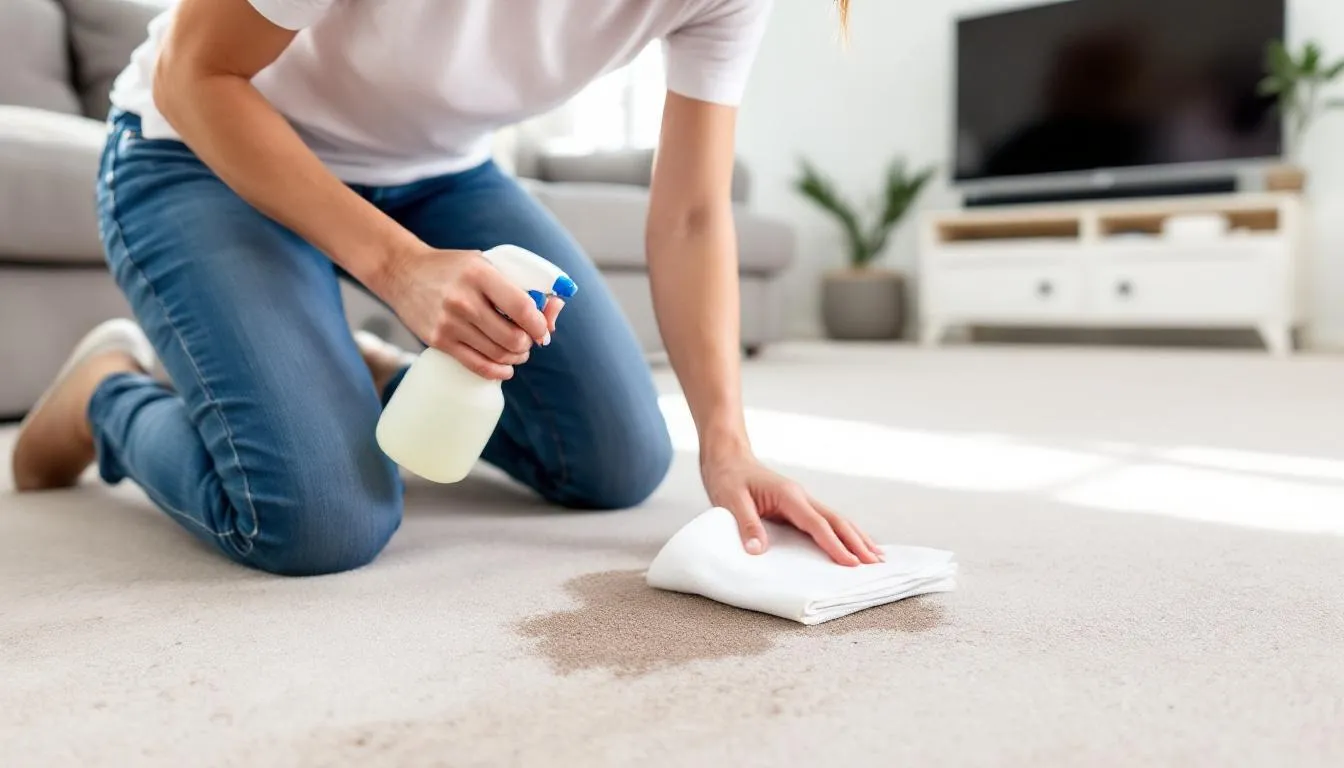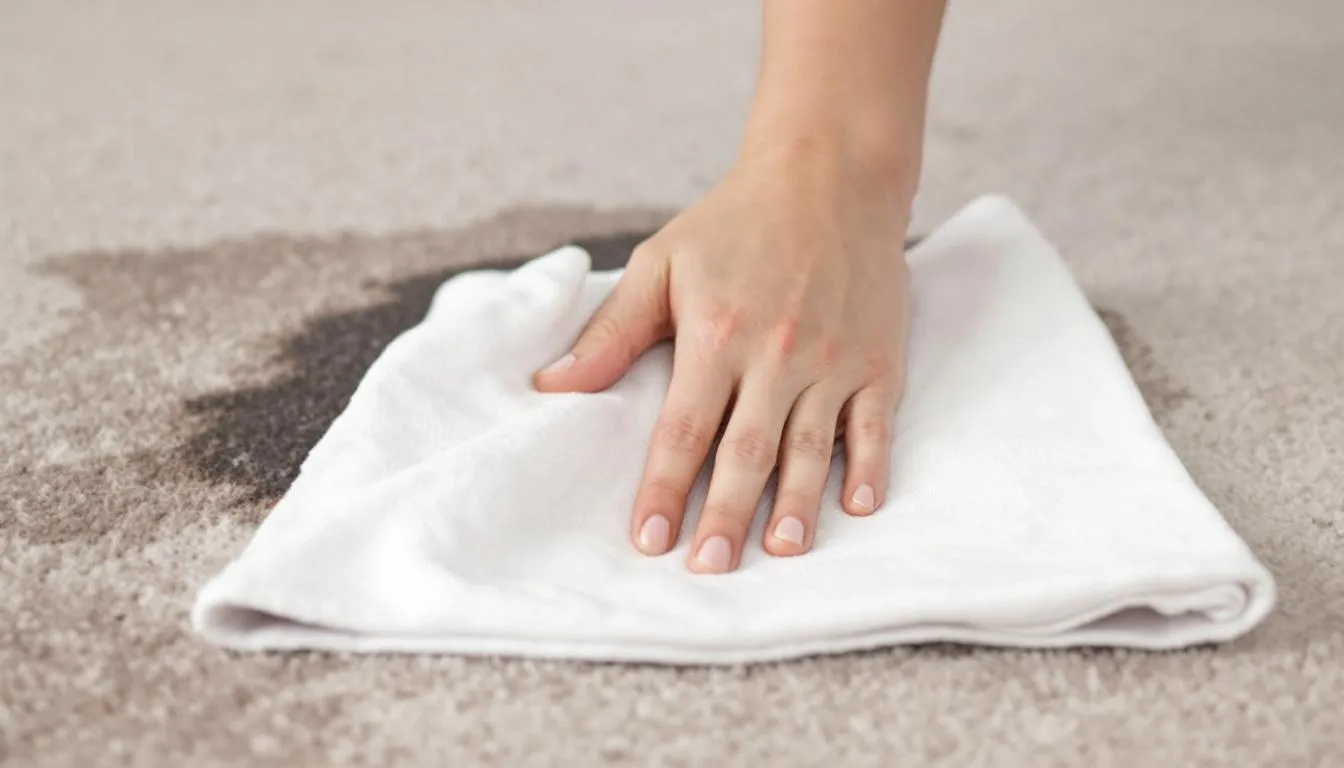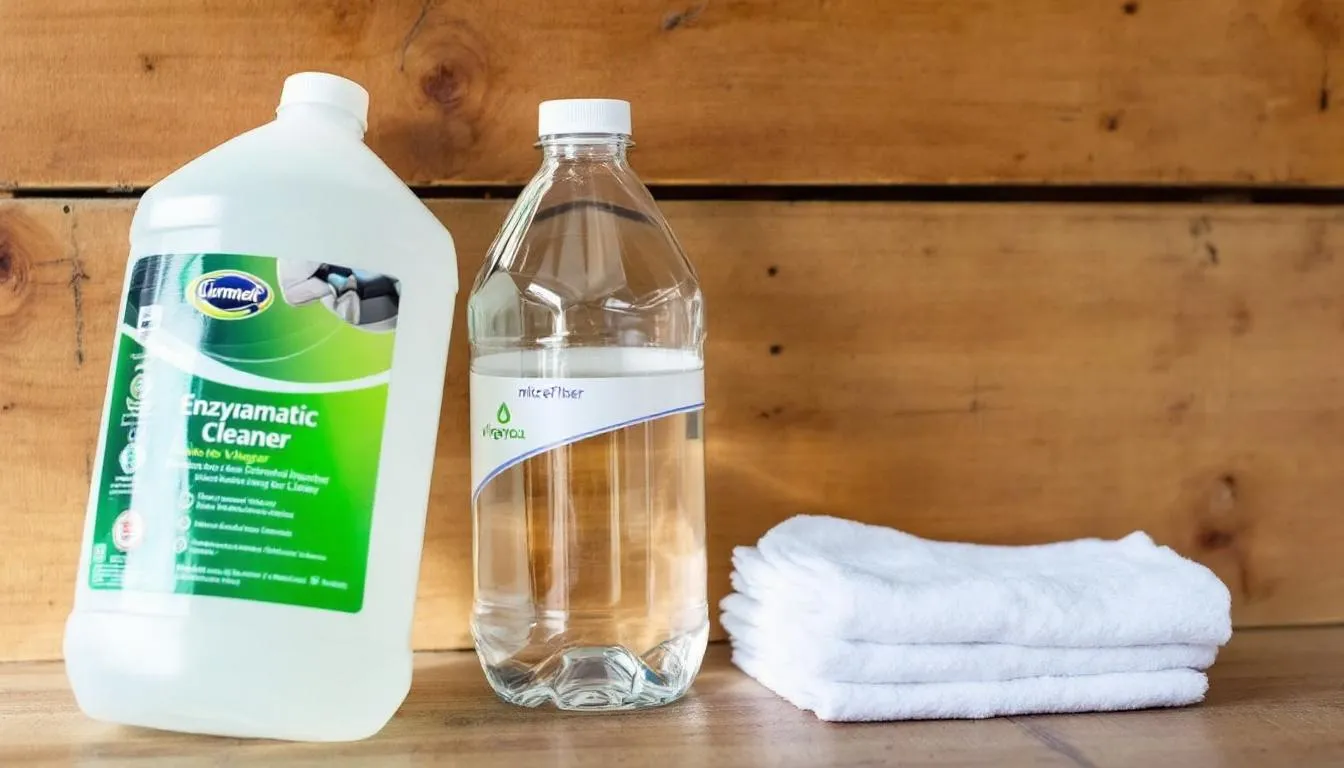

Key Takeaways
Act quickly - fresh vomit is much easier to clean than dried stains that have set into carpet fibers
- Act quickly - fresh vomit is much easier to clean than dried stains that have set into carpet fibers
- Remove solid debris first, then use enzymatic cleaners like Nature’s Miracle, carpet cleaner, or odor remover for protein-based stains and odors
- White vinegar and water solution (50/50 ratio) serves as an effective natural alternative to commercial cleaners
- Never use hot water or steam cleaners as heat will permanently set vomit stains into the carpet
- Always test cleaning products on a hidden carpet area first to prevent discoloration or damage
- Wear gloves when cleaning up dog vomit to protect your skin from bacteria and cleaning chemicals
Remove solid debris first, then use enzymatic cleaners like Nature’s Miracle, carpet cleaner, or odor remover for protein-based stains and odors
White vinegar and water solution (50/50 ratio) serves as an effective natural alternative to commercial cleaners
Never use hot water or steam cleaners as heat will permanently set vomit stains into the carpet
Always test cleaning products on a hidden carpet area first to prevent discoloration or damage
Wear gloves when cleaning up dog vomit to protect your skin from bacteria and cleaning chemicals
Every pet owner knows that sinking feeling when they walk into the family room and discover their dog vomited on the carpet. Whether your dog throws up from eating too fast, stress, or an upset stomach, the mess requires immediate attention to prevent permanent staining and unpleasant odors. The good news? With the right approach and cleaning products, most vomit stains can be completely removed from carpet fibers.
The key to success lies in speed and technique. Fresh dog vomit is significantly easier to clean than dried, set-in stains that have penetrated deep into carpet backing. This guide will walk you through everything from immediate cleanup steps to advanced stain removal techniques, helping you restore your carpet to its original condition.
Introduction to Cleaning Pet Vomit
Cleaning up dog vomit is one of the less glamorous parts of being a pet owner, but it’s a task that can’t be ignored if you want to keep your carpets and rugs looking and smelling fresh. Dog vomit, especially when it contains yellow bile, can quickly leave behind stubborn stains and unpleasant odors, particularly on light-colored carpets. Acting fast is key—pet vomit can seep into carpet fibers and become much harder to remove if left untreated.
Fortunately, with the right cleaning products and a little know-how, cleaning dog vomit doesn’t have to be overwhelming. Household cleaners like white vinegar, baking soda, and dish soap are effective tools for tackling both stains and odors. In this guide, we’ll walk you through each step of the cleaning process, from removing solid vomit to treating the area with natural and commercial cleaners. Whether you’re dealing with a fresh mess or an old stain, you’ll find practical tips to help restore your carpets and rugs, keeping your home clean and comfortable for both you and your pet.
Assessing the Stain
Before you start cleaning dog vomit from your carpet, take a moment to assess the stain so you can choose the most effective approach. Look at the color and consistency of the vomit—fresh, wet stains are usually easier to handle, while dried or crusty spots may require a bit more effort. Check the type of carpet or rug as well, since some materials are more delicate and may need gentler cleaning products.
If the vomit is still wet, put on disposable gloves and use paper towels or a clean cloth to blot up as much moisture as possible. Be careful not to rub or scrub, as this can push the stain deeper into the carpet fibers and make it harder to remove. For dried stains, you might need to sprinkle baking soda over the area to help loosen the residue before applying an enzymatic cleaner. Always work gently and methodically, and remember to use a clean cloth or fresh towels for each step to avoid spreading the mess. By carefully assessing the situation first, you’ll be able to select the right cleaner and technique, giving your carpet or rug the best chance of coming out spotless.
Immediate Steps for Fresh Dog Vomit
Time is your biggest ally when dealing with fresh pet vomit. The longer vomit sits on carpet, the deeper it penetrates into fibers and backing, making removal exponentially more difficult. Start by putting on disposable gloves to protect your hands from bacteria and stomach acids.
First, remove as much solid vomit as possible using a paper plate, spoon, or plastic scraper. Work carefully to avoid pushing the mess deeper into carpet fibers. Never use your hands directly, even with gloves, as this can spread the stain and push moisture into the carpet pad underneath.
Next, blot the liquid portion with dry paper towels, a clean cloth, or an absorbent cloth. Press down firmly but avoid rubbing or scrubbing motions, which will only drive the vomit stain deeper into the carpet. Work from the outside edges of the stained area toward the center to prevent spreading the mess across a larger area.
Dispose of all solid debris and used paper towel in sealed plastic bags to contain odors. This initial cleanup should take no more than 5-10 minutes but makes an enormous difference in the effectiveness of your subsequent cleaning efforts and helping keep your house free of lingering odors.
Best Cleaning Solutions for Dog Vomit Stains
The type of cleaner you choose depends on your carpet material, the age of the stain, and what cleaning products you have available. Enzymatic cleaners represent the gold standard for pet stains because they break down the proteins and organic compounds that cause both discoloration and lingering odors, making them highly effective to remove vomit and its associated odors.
Nature’s Miracle is widely regarded as the most effective enzymatic cleaner for dog vomit and other pet stains. These cleaners contain living enzymes that literally digest the organic matter, neutralizing odors at their source rather than simply masking them. Apply generously and allow the product to work for the full recommended time - usually 10-15 minutes.
For a natural alternative, mix equal parts white vinegar and water in a spray bottle. This solution neutralizes the acidic components in vomit while lifting stains from carpet fibers. Add a few drops of dish soap to this mixture for extra cleaning power against greasy or stubborn stains. Club soda is another popular home remedy used to remove vomit stains and odors from carpet, though it may be less effective for set-in stains.
Commercial spot cleaners like Folex Instant Carpet Spot Remover work well for surface-level fresh stains but may not penetrate deeply enough for older, set-in vomit stains. These products offer convenience and speed but shouldn’t be your first choice for serious odor problems which really encourage you to learn many ways of just How to Get Dog Vomit Out of Carpet.


Step-by-Step Cleaning Process
Once you’ve selected your cleaning solution, spray it generously over the entire stained area, extending slightly beyond the visible boundaries of the vomit stain by spraying the solution evenly to ensure full coverage. The solution needs to reach everywhere the vomit has penetrated, which is often larger than what you can see on the surface.
Allow the cleaning solution to sit for 5-10 minutes to let it soak into the carpet fibers and break down the stain, breaking down proteins and neutralizing acids. This dwell time is crucial - rushing this step significantly reduces cleaning effectiveness. While waiting, gather clean, absorbent cloths or paper towels for the blotting process.
Begin blotting with a clean cloth, applying firm downward pressure to lift the dissolved vomit and cleaning solution from the carpet. Replace cloths frequently as they become saturated. You should see the stain transferring from the carpet to your cleaning cloths - this is exactly what you want.
Rinse the area with cold water and blot dry to remove any cleaning residue that could attract dirt later. If stain or odor persists, repeat the entire process 2-3 times. Most fresh vomit stains respond well to this treatment cycle.
Removing Dried and Set-In Vomit Stains
Dried vomit presents unique challenges because proteins have bonded more strongly with carpet fibers and acids have had time to potentially damage carpet dyes. Start by gently scraping away any dried vomit particles using a plastic scraper or spoon, working carefully to avoid damaging carpet fibers.
Apply warm water (not hot) to soften the remaining residue before applying your chosen cleaner. This pre-treatment helps rehydrate the dried material, making it more responsive to cleaning solutions. Use a spray bottle to apply water evenly across the stained area.
For older stains, you’ll need stronger enzymatic cleaners specifically formulated for set-in pet stains. Products like Rocco & Roxie Professional Strength are designed for tough, aged stains and may require multiple applications spaced 24 hours apart for complete removal.
Be realistic about expectations with very old stains. If the vomit has been sitting for weeks or months, it may have permanently altered carpet dyes or fibers. In such cases, professional carpet cleaning or even carpet replacement might be your only options.
Advanced Techniques for Stubborn Stains
When standard cleaning methods fail, several advanced techniques can help tackle persistent vomit stains. The iron method involves placing a clean white towel over the stain and applying a warm iron for 30 seconds. The heat helps transfer the stain from carpet to towel, but use this technique carefully to avoid carpet damage.
A baking soda treatment can be highly effective for both stains and odors. After cleaning with your chosen solution, sprinkle baking soda generously over the damp stained area. Let the baking soda sit for 15 minutes to absorb moisture and neutralize odors, then vacuum thoroughly with a soft bristled brush attachment.
For deep carpet penetration, consider renting a steam cleaning machine, but use only the cool setting. Heat will set protein stains permanently, so avoid hot water or steam. Professional-grade pet stain neutralizers like Anti Icky Poo can handle persistent odors that resist other treatments.


What NOT to Do When Cleaning Dog Vomit
Avoiding common mistakes is just as important as following proper cleaning procedures. Never use hot water or steam on fresh vomit stains - heat permanently sets protein-based stains into carpet fibers, making them impossible to remove. Always use cold or room temperature water for rinsing.
Avoid rubbing or scrubbing motions that push vomit deeper into carpet backing and padding. The blotting process requires patience, but it’s the only way to lift stains rather than spread them. Aggressive scrubbing can also damage delicate carpet fibers and create permanent texture changes.
Don’t use bleach or ammonia-based household cleaners on carpet vomit stains. These chemicals can damage carpet dyes, create toxic fumes when mixed with other substances, and may actually set certain types of stains. Stick to products specifically designed for carpet cleaning.
Excessive amounts of baking soda might seem helpful, but too much can clog vacuum filters and leave white residue in carpet fibers. Use baking soda sparingly and vacuum thoroughly after treatment. Always perform a spot test with any cleaner in an inconspicuous area before treating visible stains.
Preventing Future Carpet Stains
Prevention starts with understanding why your dog vomits and addressing underlying causes. Monitor your dog’s eating habits – dogs that eat too quickly often vomit shortly after meals. What your dog eats can also influence vomiting, so establishing a consistent routine is especially important for a puppy. Slow feeding bowls or puzzle feeders can help prevent this common trigger.
Keep your dog away from garbage, human food scraps, and outdoor substances like grass or mulch that commonly cause stomach upset and vomiting. Consult vets for advice on diet and routines to ensure your dog’s good health and reduce vomiting incidents. Regular vet checkups are important for maintaining your dog's good health and catching any issues early.
Consider washable area rugs or carpet protectors in areas where your dog spends most of their time. These barriers can be easily removed and cleaned if accidents occur, protecting your expensive carpeting underneath. Some pet owners find success training their dogs to use designated uncarpeted areas when feeling unwell.
When to Call Professional Carpet Cleaners
Some situations require professional intervention rather than DIY cleaning attempts. Large or multiple stains covering significant carpet area often exceed what household cleaning products can handle effectively. Professional cleaners have industrial-grade equipment and specialized solutions for extensive damage.
Expensive or antique carpets warrant professional care to prevent accidental damage from improper cleaning techniques. Oriental rugs, wool carpets, and other delicate materials require specialized knowledge and pH-balanced cleaning solutions that professionals can provide.
If persistent odors remain after multiple DIY cleaning attempts, professional cleaners can address contamination that has reached carpet padding or subfloor. They have extraction equipment that can remove moisture and contaminants from deeper layers that home cleaning cannot reach.
Time constraints matter too. If you can’t clean dog vomit within 24-48 hours of occurrence, professional cleaning becomes much more valuable. The longer vomit sits, the more likely it becomes a permanent stain requiring professional-grade treatment.
FAQ
How long do I have to clean dog vomit before it permanently stains my carpet?
Fresh vomit should be cleaned within 30 minutes to prevent staining, while you have up to 24 hours before stains become significantly more difficult to remove. After 48 hours, vomit can penetrate deep into carpet padding and may require professional treatment.
Can I use hydrogen peroxide to clean dog vomit from colored carpets?
Hydrogen peroxide acts as a bleaching agent and can permanently lighten or discolor colored carpets. It’s only safe to use on white or very light-colored carpets, and even then should be tested in an inconspicuous area first.
Why does my carpet still smell like vomit even after cleaning?
Lingering odors usually indicate that vomit has soaked through to the carpet padding underneath. You may need to lift the carpet and clean the padding separately, or the odor-causing bacteria require an enzymatic cleaner specifically designed to break down organic matter.
Is it safe to use carpet cleaning machines on dog vomit stains?
Carpet cleaning machines are safe to use, but only with cool or room temperature water. Hot water will set protein-based vomit stains permanently. Make sure to extract as much moisture as possible to prevent mold growth in carpet padding.
How many times should I repeat the cleaning process for tough stains?
Most fresh stains require 2-3 cleaning cycles, while dried or set-in stains may need 4-5 treatments spaced 24 hours apart. If you see no improvement after the third attempt, the stain may be permanent or require professional intervention.
FAQ
How long do I have to clean dog vomit before it permanently stains my carpet?
Fresh vomit should be cleaned within 30 minutes to prevent staining, while you have up to 24 hours before stains become significantly more difficult to remove. After 48 hours, vomit can penetrate deep into carpet padding and may require professional treatment.
Can I use hydrogen peroxide to clean dog vomit from colored carpets?
Hydrogen peroxide acts as a bleaching agent and can permanently lighten or discolor colored carpets. It’s only safe to use on white or very light-colored carpets, and even then should be tested in an inconspicuous area first.
Why does my carpet still smell like vomit even after cleaning?
Lingering odors usually indicate that vomit has soaked through to the carpet padding underneath. You may need to lift the carpet and clean the padding separately, or the odor-causing bacteria require an enzymatic cleaner specifically designed to break down organic matter.
Is it safe to use carpet cleaning machines on dog vomit stains?
Carpet cleaning machines are safe to use, but only with cool or room temperature water. Hot water will set protein-based vomit stains permanently. Make sure to extract as much moisture as possible to prevent mold growth in carpet padding.
How many times should I repeat the cleaning process for tough stains?
Most fresh stains require 2-3 cleaning cycles, while dried or set-in stains may need 4-5 treatments spaced 24 hours apart. If you see no improvement after the third attempt, the stain may be permanent or require professional intervention.






